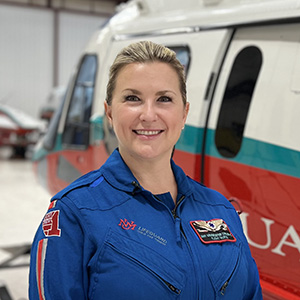CDC Updates to Respiratory Virus, COVID Guidelines

UNM Lifeguard Training: Putting Patient Safety First
How do you prepare for a worst-case scenario? That is something The University of New Mexico Hospital Lifeguard Team does four times a year.
With two planes and one helicopter, the medical transport crew is equipped to respond to emergencies all over the state, and quickly. The team, made up of RNs, nurse practitioners, paramedics, respiratory therapists and physicians, carefully move and treat thousands of patients each year, whether it is a child in rural New Mexico who needs immediate cancer care or people who were involved in a serious car crash.
Amy Armbruster, RN, CCRN, CFRN, NRP, FPC is a flight nurse and educator for UNM Hospital Lifeguard. She said quarterly training simulations teach first responders to expect the unexpected and prioritize patient safety in complex and high-pressure situations.

No other team, no other nurse, medic or flight physician is going to get this training anywhere else.
Armbruster explained how first responders walk to each patient and verbally assign them a color. “Green” means a patient is walking wounded or does not need urgent treatment. “Yellow” patients need more urgent treatment, “red” patients need the most urgent treatment, and patients categorized as “black” are deceased. Then, the team jumps into action to provide the appropriate treatment to as many patients as they can at one time, careful to only move a patient if and when it is medically necessary.
Each scenario ran for about 30 minutes. Multiple groups of trainees, assisted by first responders with Cochiti Fire and Rio Rancho Fire and Rescue, had only two minutes to gather vital information and make a plan before arriving on scene.
While on scene, they quickly divided and checked on each patient, determining which needed the most critical treatment. They applied torniquets, opened airways and performed CPR. When the teams finished, they debriefed with their instructors on what they did well and what they could improve on.
“Every time you have a trauma, it is going to be difficult,” one of the trainees said in the group discussion, shortly after completing his scenario. “Especially with kids.”
The trainee explained how children can be difficult to diagnose during a catastrophic event because they are often scared, in shock, and do not know how to explain their injuries. This can make it especially difficult to categorize the severity of their injury and assign them a color before moving on to other patients.
One of the educators responded, saying it is a hard call, and it can be even harder when a patient is unresponsive. To act quickly but to also act correctly is not easy. That is why Armbruster said she and her colleagues put weeks of effort and planning into each Lifeguard training session.
“Emergency events like this happen more often than you would think, unfortunately,” she said. “We have to train for the worst of the worst. We do have two major highways that intersect here in New Mexico. So, you do hear of unfortunate accidents that have multiple patients, and that is why we have to train this way.”
During each training period, teams respond to a pediatric simulation and an adult simulation.
“What is great about this is we have access to the most advanced equipment, and it gives us time to practice advanced procedures,” Armbruster said. “We have education quarterly as well. So, it all ties in together, and no other team, no other nurse, medic or flight physician is going to get this training anywhere else.”
She said that top of the line training makes a world of difference for patients and their loved ones.
“It is a parent’s worst nightmare for their child to be very sick or injured,” Armbruster said. “I am a mother, and many of our team members are parents. I can tell you that you know 100 percent, we will treat your child like they are our own, and you can rest assured that they are in the best hands possible, and they are going to get the best care from anybody on this team.”
Learn more about the UNM Lifeguard Team here.
Read more from recent stories about UNM Lifeguard’s work in action:
